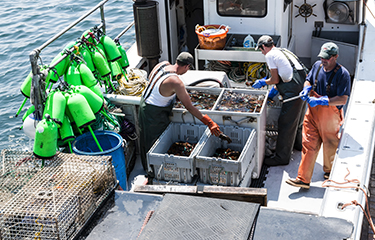Lobster boat prices have reached record prices this summer, driving some restaurants to shy away from carrying the product to avoid sticker shock for customers.
Boat prices have climbed well north of USD 6.00 (EUR 5.08) per pound when the price is typically around USD 4.00 (EUR 3.39) per pound, the Lewiston Sun-Journal reported. Some restaurants interviewed by the newspaper confessed to removing lobster from menus to avoid charging an exorbitant amount of money for the product.
The price is so high The New York Times reported on lobster rolls costing as much as USD 34.00 (EUR 28.83) per roll – a price that some businesses say customers seem to be willing to pay.
The reason for the high prices is multi-faceted, Maine Lobster Dealers' Association Executive Director Annie Tselikis told SeafoodSource. However, it boils down to the basic law of supply and demand.
“The price of lobster is constantly connected to the price that is dictated by the market,” she said. “What we’re looking at right now is straight-up supply and demand.”
The price is at more than double what it was just 10 years ago, Tselikis said, with live lobsters going for record prices and the price of lobster meat costing even more.
Tselikis attributes the cost to the soaring demand for the product as consumers who dealt with the COVID-19 pandemic for more than a year begin to buy lobster again.
“The pandemic is a huge driver. It’s the fact that people are out and restaurants are open,” Tselikis said. “You add on top of that that people have basically been holed up for a year-and-a-half, and they’re out and looking to celebrate and they’re doing that with great products like lobster.”
The high price has nothing to do with supplies being more constrained than usual. The influx of catch from Canada’s spring lobster fishery showcased that demand has soared.
“In the spring lobster fishery in Canada, there’s usually 100 million pounds of product that are landed in the fishery. This season hardly made a dent to the supply situation,” Tselikis said.
The supply of lobster is relatively fixed and based on what can be caught, so when demand increases, the price follows.
“It’s not really even low supply, it’s just high demand related to what the supply is,” Tselikis said. “We can’t create more of these things. We do not farm them, it does not work that way. So the supply is the supply and the demand is unprecedented.”
The unprecedented demand followed a period in which lobster inventories were already low, Cozy Harbor CEO John Norton told SeafoodSource.
“From what I see, there’s no inventory building up anywhere in the system,” he said.
As early as March, the supply chain had relatively little product anywhere in the system, and demand has continued to prevent supplies from building up, Norton said.
“There was nothing in the pipeline. [It was] completely dry at the start of the season, and everybody has been hand-to-mouth trying to get something to end-users,” Norton said. “Right now, the industry is still in the process of just getting product for daily sales just out to the restaurants and casinos and supermarket chains. Nothing is building up.”
Established processors, he added, tend to have robust enough supply chains that getting access to the raw materials needed isn’t an issue.
“For the most part, most companies that are regular purchasers of raw material in Maine have their supply chains very well-established. So there’s no trouble getting raw material when you’ve got an established supply chain," Norton said. "It’s just that it’s expensive this year, because some people don’t have supply chains established.”
Those companies without supply chains are helping to drive prices up, he said.
“Certainly there’s high pricing on the shore," he said. "We’re at record prices on the shore at this time of year."
Lobster fishermen aren't the only ones seeing record-high prices for its product. As early as February, king crab prices were at record highs, yet consumers continued to buy the product in record amounts at retail.
“It is challenging, but everybody is dealing with the same thing,” Tselikis said. “All the luxury goods are up, but so is the price of chicken, and packaging, and packaged goods.”
Even with the high prices, demand for lobster continues to grow unabated, Tselikis said.
“If you are a hip restaurant or you’re a white tablecloth restaurant and you operate somewhere in the Northeast, you have to have lobster on your menu,” Tselikis said. “There are tons of other applications for lobster, and it turns out that the businesses that are responsible for promoting and distributing this product are very good at their jobs.”
Tselikis said the industry has gotten used to dealing with crises, from bait and regulatory issues, to a trade war that caused exports to plunge, to COVID-19, all in the span of a few years.
“We handled the unprecedented, just fill in the blank for whatever the unprecedented thing is,” Tselikis said.
Now that the market is emerging from one of its biggest challenges ever, the lobster industry is excited to see demand for the product hasn’t gone anywhere, Tselikis said.
“Everybody is having the same conversations with their customers,” Tselikis said. “They say why the price is the price right now, and the customers still buy.”
Photo courtesy of WoodysPhotos/Shutterstock







